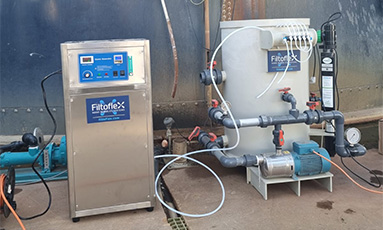F&B Wastewater Treatment to Reduce Sulfides
A juice F&B manufacturing company contacted Filtoflex to test using Nanobubble Ozone Systems to treat pollutants and dissolved sulfides in their wastewater. The plant routinely failed to meet environmental standards due to high dissolved sulfide levels. As a result, they received fines and potential legal ramifications.
The F&B plant’s sewage included many pollutants with fluctuating levels throughout the day and season. Their wastewater is treated at a plant located near the F&B factory where it undergoes a biological process using anaerobic reactors, and then enters a Dissolved Air Flotation (DAF) facility before being discharged into the public sewer system.
The anaerobic reactors the F&B plant has been using until now helped break down the pollution in the wastewater without oxygen. However, the process generates sulfates that become dissolved sulfides which pose an environmental hazard if left untreated. To manage sulfide levels in wastewater, it is important to oxygenate the water at the end of the treatment process.
The aim of the experiments was to reduce the concentration of dissolved sulfides and pollutants in the F&B plant’s wastewater and achieve environmental regulatory standards.

Project ID
Location
F&B Juice Manufacturer, IsraelSystem
Applications
Type
In-shore systemYear
2023The plant is routinely monitored for environmental compliance with water and sewerage standards by the regional council’s regulatory representatives. The plant’s tested samples revealed the presence of contaminants and dissolved sulfides at 15 mg/L, higher than acceptable levels. As a result of repeated failure to meet environmental standards, the F&B company received fines and is subject to potential legal ramifications. To address this challenge, the F&B plant tested Filtoflex’s Nanobubble Ozone Systems to treat the pollutants and dissolved sulfides present in their wastewater. The delivery of ozone as an oxidizer through Filtoflex’s Nanobubble technology is a unique approach to wastewater treatment.
Custom-fitted Filtoflex Nanobubble Ozone Systems were installed at the F&B Plant to conduct the treatment tests on the facility’s wastewater.
Filtoflex’s technology is designed to create cost-effective and sustainable nanobubbles that contain Air, oxygen, or ozone for effective water/wastewater treatment. The technology is based on gas flow (in our case, ozone) at low (negative) pressure in a liquid medium, which creates submicronic bubbles – Nanobubbles. These bubbles have a negative charge and a large surface area relative to the diameter of the bubble, which causes the bubbles to maintain long-term stability in the liquid while their internal pressure is significantly higher than the pressure in the environment (the liquid).
The ozone oxidizer, combined with its introduction into wastewater in the form of nanobubbles, allows non-oxidation selection of the various pollutants and on the other hand the most contact time and area between the same oxidizer and the pollutant. The result is almost complete oxidation of the pollutants.
Several experiments were conducted to evaluate the effectiveness of Nanobubble Ozone technology at the F&B company’s wastewater treatment plant. Samples of wastewater were collected from two different stages: after the Dissolved Air Flotation (DAF) facility and after the fusion of the biological process, specifically an anaerobic reactor. These two locations differed in terms of pollutant composition and water quality. Each experiment had a duration of approximately 90 minutes, with the majority of reactions occurring during the initial half of the experimental periods.
The results of the experiments demonstrated impressive results.
Dissolved Sulfide
Before treatment: 15 mg/L
After treatment: 0.5 mg/L
COD (Chemical Oxygen Demand)
Before treatment: 2000
After treatment: 800
pH
Before treatment: 6.2
After treatment: 7.5-8
Filtoflex Nanobubble Ozone treatment succeeded in substantially reducing the dissolved sulfide levels to surpass the regulatory standards and also improved the organic load and pH levels in the F&B juice manufacturer’s wastewater.
